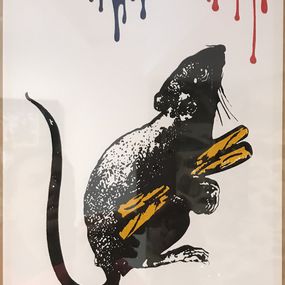


Homeless in Paris
Blek Le Rat
Painting - 161.29 x 129.54 x 2.54 cm Painting - 63.5 x 51 x 1 inch
$45,000















The Street Artist Paraphernalia (Framed)
Blek Le Rat
Print - 23 x 31 cm Print - 9.1 x 12.2 inch
Sold






Getting Through Walls: Book & Print Special Edition
Blek Le Rat
Print - 26.9 x 34.6 x 1 cm Print - 10.6 x 13.6 x 0.4 inch
Sold


Le Guerrier – édition spéciale
Blek Le Rat
Print - 23 x 31 x 0.1 cm Print - 9.1 x 12.2 x 0 inch
Sold




Biography
Blek le Rat (born Xavier Prou, 1952) was one of the first graffiti artists in Paris, and has been described as the "Father of stencil graffiti".
Xavier Prou was born in Boulogne-Billancourt in the western suburbs of Paris. Prou began his artwork in 1981, painting stencils of rats on the walls of Paris streets. He described the rat as "the only free animal in the city", and one which "spreads the plague everywhere, just like street art". His name originates from the comic book Blek le Roc, using "rat" as an anagram for "art".
Initially influenced by the early graffiti-art of New York City after a visit in 1971, he chose a style which he felt better suited Paris, due to the differing architecture of the two cities. He also recognised the influence of Canadian artist Richard Hambleton, who painted large-scale human figures in the 1980s. He is credited with inventing the life-sized stencil, and recognised as the first to transform stencil from basic lettering into pictoral art. His oldest preserved street art graffito, a 1991 replica of Caravaggio's Madonna di Loreta, which he dedicated to his future wife Sybille, was rediscovered behind posters on a house wall in Leipzig, Germany, in 2012.
French authorities identified Blek in 1991 when he was arrested while stencilling a replica of Caravaggio's Madonna and Child, with the connection to Blek and his artwork being made by police. From that point on, he has worked exclusively with pre-stenciled posters, citing the speedier application of the medium to walls, as well as lessened punishment should he be caught in the act.
He has had a great influence on today's graffiti-art and "guerilla-art" movements, the main motivation of his work being social consciousness and the desire to bring art to the people. Many of his pieces are pictorials of solitary individuals in opposition to larger, oppressive groups. He has also been noted for his series of images representing the homeless, begun in 2006, which depict them standing, sitting, or lying on sidewalks, in attempts to bring attention to what he views as a global problem.
British graffiti artist Banksy has acknowledged Blek's influence stating "every time I think I've painted something slightly original, I find out that Blek Le Rat has done it as well, only twenty years earlier." The two have expressed mutual desire for collaboration; in 2011, Blek was seen adding to a mural begun the previous year by Banksy in the Mission District, San Francisco.
Blek initially disagreed with those who claim Banksy has copied his work: "People say he copies me, but I don't think so. I'm the old man, he's the new kid, and if I'm an inspiration to an artist that good, I love it. I feel what he is doing in London is similar to the rock movement in the Sixties." More recently, however, in the documentary Graffiti Wars, Blek took a different tone, stating, "When I see Banksy making a man with a child or Banksy making rats, of course I see immediately where he takes the idea. I do feel angry. When you're an artist you use your own techniques. It's difficult to find a technique and style in art so when you have a style and you see someone else is taking it and reproducing it, you don't like that. I'm not sure about his integrity. Maybe he has to show his face now and show what kind of guy he is."
Nationality
Categories
Artistic movements
Themes







